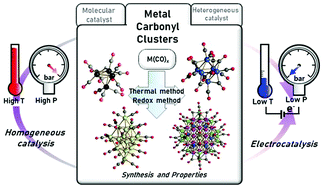Metal carbonyl clusters of groups 8–10: synthesis and catalysis†
Abstract
In this review article, we discuss advances in the chemistry of metal carbonyl clusters (MCCs) spanning the last three decades, with an emphasis on the more recent reports and those involving groups 8–10 elements. Synthetic methods have advanced and been refined, leading to higher-nuclearity clusters and a wider array of structures and nuclearities. Our understanding of the electronic structure in MCCs has advanced to a point where molecular chemistry tools and other advanced tools can probe their properties at a level of detail that surpasses that possible with other nanomaterials and solid-state materials. MCCs therefore advance our understanding of structure–property–reactivity correlations in other higher-nuclearity materials. With respect to catalysis, this article focuses only on homogeneous applications, but it includes both thermally and electrochemically driven catalysis. Applications in thermally driven catalysis have found success where the reaction conditions stabilise the compounds toward loss of CO. In more recent years, MCCs, which exhibit delocalised bonding and possess many electron-withdrawing CO ligands, have emerged as very stable and effective for reductive electrocatalysis reactions since reduction often strengthens M–C(O) bonds and since room-temperature reaction conditions are sufficient for driving the electrocatalysis.

- This article is part of the themed collection: Multimetallic Clusters: Synthesis, Reactivity and Properties


 Please wait while we load your content...
Please wait while we load your content...